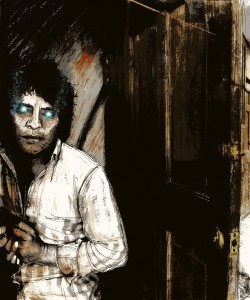An academic paper by Flavius Vulnificus, PhD, as provided by Carl Grafe
Art by Luke Spooner
ABSTRACT
While electrical brain stimulation is commonly used as a treatment for disorders like Parkinson’s disease and epilepsy, the neurological effects of direct exposure to electric pulses over time are not clearly understood. In order to investigate the matter, I developed a novel battery-powered device that would, when implanted at the base of the cranium, send a steady current of electricity into the basal ganglia of the brain. The trial is ongoing, but in the short time since I implanted the device, dramatic alterations in mood and behavior have been observed.
INTRODUCTION
The sequence of events that resulted in this experiment requires some explanation. As you have likely already noted from my name, I have in recent years published several psychological papers while employed as a tenure-track faculty member at the University of Houma. After five years of teaching classes, publishing papers, and, in my view, reasonably tolerating the slew of political and interpersonal tedium that is imbued in academia–particularly in psychology departments–I was suddenly and inexplicably terminated. The official reason given was that my “personality disorders” were disrupting other professors’ ability to do their work. I’m sure you can imagine the relish with which the chair of a psychology department would slap that diagnosis on one of her subordinates. Although I had been involved in some lighthearted sabotage–just pranks, really–of several co-workers’ research projects in order to improve the morale of the department–which I might add was sorely needed given everyone’s apparent inability to take a joke–I know the real reason for the dismissal was jealousy. Approximately $600,000 worth of research funding was received by my colleagues the year I left ($500,000 worth of which I subsequently destroyed, ha ha!), and yet all of it was worthless, mere children’s toys compared to the neural electrophoresis work I was engaged in. Yet it was ended with the simple swish of a signature on a pink slip.
After struggling for several months to find another position commensurate with my superior ability, my house foreclosed and I moved into my mother’s basement, where I now reside. Dark were the months that followed, filled with daytime television and frozen pizzas. Initially, the very thought of such a lifestyle would have made me shudder, but I have to admit I’ve started to develop a bit of a taste for it–especially Mexican-style. Anyway, after months of depression and languor, I was one day immersed in an installment of “General Hospital” when it occurred to me: I’m a PhD psychologist! Why am I sitting around miserable when I can self-treat? There was no institutional review board to stop my research, no chair or dean or university president to inhibit the ideas that my mind alone could summon. I could do it all on my own. And thus this research study was initiated.
To read the rest of this story, check out the Mad Scientist Journal: Summer 2013 collection.
Dr. Flavius Vulnificus served for several years as a distinguished professor of psychology at the University of Houma. His studies at the University were primarily devoted to neural electrophoresis, an area of research he has continued to pursue in independent practice — his latest results have been prominently featured for the past several nights on the evening news. He enjoys practical jokes, long walks on the beach, and collecting memorabilia.
Carl Grafe lives with his family in the Salt Lake Valley, which he enjoys on days when it’s not snowing. His nascent career as a mad scientist ended abruptly in fourth grade when he tried to convert a record player into a robot arm in a rainstorm and received some electric pulse stimulation therapy as a result.
Luke Spooner a.k.a. ‘Carrion House’ currently lives and works in the South of England. Having recently graduated from the University of Portsmouth with a first class degree he is now a full time illustrator for just about any project that piques his interest. Despite regular forays into children’s books and fairy tales his true love lies in anything macabre, melancholy or dark in nature and essence. He believes that the job of putting someone else’s words into a visual form, to accompany and support their text, is a massive responsibility as well as being something he truly treasures. You can visit his web site at www.carrionhouse.com.
Follow us online:
